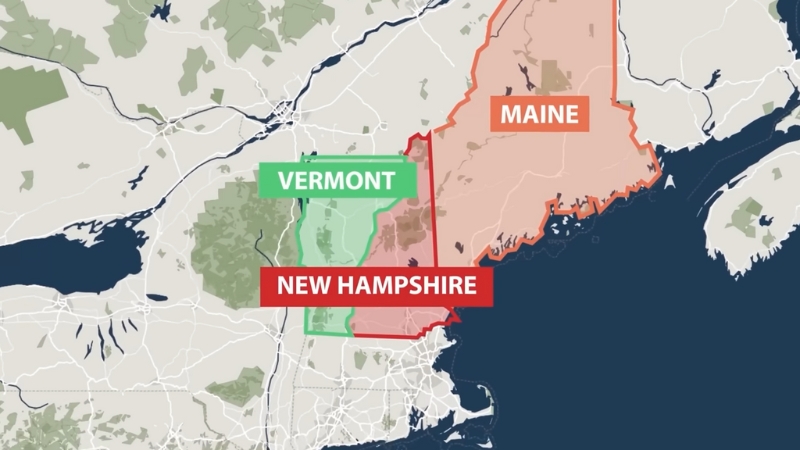As of 2025, New Hampshire’s population is estimated at 1,405,100, reflecting its status as one of the original thirteen states with a rich history according to the World Population Review.
Known for being the first to establish a constitution and an independent government separate from Great Britain in January 1776, New Hampshire maintained one of the slowest growth rates in the country at just 0.16%, ranking 45th nationally.
Bordering Maine to the east, Massachusetts to the south, and Vermont to the west, New Hampshire also shares a small northern boundary with the Canadian province of Quebec.
Key Takeaways
Age Distribution

Gender Composition

- New Hampshire has a slightly higher percentage of females (50.16%) compared to males (49.84%), similar to the national trend but with a narrower gap.
- The gender ratio in New Hampshire, at 99.3 males per 100 females, indicates a relatively balanced distribution.
Race/Ethnicity Distribution

- The population in New Hampshire remains predominantly White (91.03%), reflecting less racial diversity compared to national averages according to the Neilsberg.
- The Hispanic or Latino population (4.07%) represents a growing segment of the population, although it is still relatively small.
- Minority racial groups collectively account for 8.97% of the population, with Asians (2.67%) being the largest minority group.
Counties of New Hampshire 2025
WPR notes that New Hampshire has 10 counties, with Hillsborough County being the most populous, housing 415,427 residents (30.61% of the state population) and experiencing a 3.54% growth since 2010. Rockingham County follows with 309,176 residents (22.79%) and 4.70% growth, and Merrimack County ranks third with 151,132 residents (11.14%) and 3.24% growth. At the other end, Coos County has the fewest residents at 31,589 (2.33%) and a population density of 17.6 persons per square mile, followed by Sullivan County (43,144 residents, 3.18%) and Carroll County (48,799 residents). Strafford County recorded the highest growth rate at 5.60%, with seven counties overall experiencing growth since 2010. However, three counties—Coos County (-4.20%), Sullivan County (-1.41%), and Cheshire County (-0.73%)—saw population declines. New Hampshire had 34,000 job openings in August 2024, unchanged from July, with a job openings rate of 4.6%, consistent with July. This indicates a stable demand for labor in the state according to the BLS. The hires count remained steady at 27,000, suggesting consistency in employment additions. Total separations dropped significantly from 27,000 in July to 21,000 in August (-6,000), marking a notable decline in job turnover. In October, U.S. job separations increased by 65,000 to 5.26 million. Within separations, quits rose by 228,000 to 3.33 million, while layoffs and discharges declined 169,000 to 1.63 million #JOLTS https://t.co/lo5PBjz2VX pic.twitter.com/QD3UUbOR6B — St. Louis Fed (@stlouisfed) December 7, 2024 Quits decreased slightly from 13,000 in July to 12,000 in August, a sign of reduced voluntary employee movement. Layoffs and discharges saw a sharper decline, dropping from 12,000 in July to 7,000 in August (-5,000), indicating improved job security for workers. According to the Bureau of Labour Statistics, the civilian labor force increased steadily from 769.1k in May to 772.8k in October, reflecting ongoing workforce participation growth. Employment rose from 749.7k in May to 753.7k in October, indicating job growth and economic stability over the period. Unemployment peaked at 20.1k in August, corresponding to a slight uptick in the unemployment rate to 2.6%. However, it dropped back to 19.1k in October, bringing the rate down to 2.5%. Despite slight fluctuations in unemployment, the unemployment rate remained stable at 2.5% for most months, except for a temporary rise to 2.6% in August. New Hampshire exhibits significantly higher income levels compared to the national average. The state’s average household income of $118,118 is 12% higher than the U.S. average, indicating strong economic health and well-paying opportunities according to the Income By Zip Code.
County
Population
Growth Rate (%)
Area (sq mi)
Population Density (per sq mi)
Hillsborough County
427,215
1.02%
339
487
Rockingham County
321,745
2.26%
268
463
Merrimack County
157,747
2.41%
360
169
Strafford County
133,915
2.17%
142
365
Grafton County
93,161
2.15%
660
55
Cheshire County
77,943
1.82%
273
110
Belknap County
65,349
2.47%
155
163
Carroll County
52,742
4.97%
360
57
Sullivan County
44,020
2.21%
208
82
Coos County
31,268
0.13%
693
17
Labor Market
Metric
August 2023
May 2024
June 2024
July 2024
August 2024 (Preliminary)
Change (July to August)
Job Openings
42,000
38,000
38,000
34,000
34,000
0
Job Openings Rate (%)
5.7
5.1
5.1
4.6
4.6
0.0
Hires
29,000
25,000
27,000
27,000
27,000
0
Hires Rate (%)
4.2
3.5
3.8
3.8
3.8
0.0
Total Separations
22,000
29,000
29,000
27,000
21,000
-6,000
Separations Rate (%)
3.1
4.1
4.1
3.8
3.0
-0.8
Quits
12,000
17,000
12,000
13,000
12,000
-1,000
Quits Rate (%)
1.7
2.4
1.7
1.8
1.7
-0.1
Layoffs & Discharges
7,000
10,000
15,000
12,000
7,000
-5,000
Layoffs Rate (%)
1.0
1.4
2.1
1.7
1.0
-0.7
The separations rate fell to 3.0%, reflecting a slowdown in employee exits from the workforce.Employment Rate
Income Stats
Metric
New Hampshire
United States
Average Household Income
$118,118 (12% higher)
$105,833
Median Household Income
$90,845 (21% higher)
$75,149
Average Salary (Full-Time)
$84,846
Not provided
Median Salary (Full-Time)
$64,512
Not provided
Median Income (Single-Person)
$41,888
Not provided
Average Income per Person
$48,250
Not provided
Average Family Income
$140,123
Not provided
Median Family Income
$113,605
Not provided
The median household income of $90,845, which is 21% higher than the national median, reflects a higher concentration of middle-income and affluent households.
The average salary for full-time workers ($84,846) further supports the notion of a competitive labor market. New Hampshire’s family income levels, with averages exceeding $140,000, illustrate the financial strength of households with multiple earners.
New Hampshire Income Levels (2025)

The income distribution in New Hampshire reveals a significant proportion of households in the middle to upper-income brackets. 14% of households earn $200,000 or more, indicating a notable presence of high-income families.
Middle-income groups, such as those earning between $75,000 and $199,999, collectively account for approximately 45% of households, suggesting a well-balanced income structure.
Lower-income brackets, such as those earning less than $50,000, each constitute about 3% of households, reflecting lower levels of poverty compared to many states. These figures highlight New Hampshire’s strong economic base, with most households achieving financial stability or higher.
Housing Market Trends
Metric
Value
Year-over-Year Growth
Median Sale Price
$490,700
+7.1%
# of Homes Sold
1,471
+2.7%
Median Days on Market
40
+12 days
# of Homes for Sale
4,966
+8.9%
# of Newly Listed Homes
1,583
+1.0%
Months of Supply
2 months
No change
Homes Sold Above List Price
45.1%
-6.9 points
Homes with Price Drops
27.8%
+3.2 points
Sale-to-List Price Ratio
99.9%
-1.0 point
The median sale price increased by 7.1% year-over-year, reaching $490,700, reflecting a strong demand for housing in the state as noted by Redfin.
Cities like Manchester (+15.4%) and Concord (+14.9%) experienced the fastest growth in sale prices, while Salem (-9.9%) and Portsmouth (-10.7%) saw declines.
The number of homes for sale rose by 8.9% year-over-year, with a total of 4,966 homes available, indicating that supply is beginning to catch up with demand.
Newly listed homes increased modestly by 1.0%, with 1,583 homes entering the market.
Top 10 Metros in New Hampshire with Fastest Growing Sales Price (Year-over-Year Growth)

45.1% of homes sold above the list price, down 6.9 points year-over-year, signaling reduced competition compared to last year.
Homes with price drops rose to 27.8%, reflecting a cooling market.
The median days on the market increased to 40 days, a 12-day rise year-over-year, suggesting homes are taking longer to sell.
Despite this, the sale-to-list price ratio remained high at 99.9%, indicating that sellers are still securing close to their asking prices.
Education Stats

Census.gov shows a significant proportion of New Hampshire’s population has attained a bachelor’s degree (24.6%) or a graduate/professional degree (16.2%), bringing the total with a bachelor’s degree or higher to 40.7%, which surpasses the national average of 36.2%.
With 27.0% holding a high school diploma as their highest level of education, the state demonstrates a strong foundation in basic education. A notable 16.8% have pursued higher education without completing a degree, suggesting opportunities for further education initiatives. School Enrollment (Population 3 Years and Over Enrolled in School) in New Hampshire.

The majority of enrolled students (65.6%) are in Kindergarten through 12th grade, slightly below the national average of 67.8%, reflecting New Hampshire’s focus on primary and secondary education.
College undergraduate enrollment accounts for 21.8%, indicating strong participation in post-secondary education.
Nursery and preschool enrollment is relatively low at 5.6%, suggesting potential areas for growth in early childhood education programs.
Disability Statistics in New Hampshire (2023)
Metric
New Hampshire
United States
Disabled Population (%)
13.7% ± 0.5%
13.6% ± 0.1%

- New Hampshire’s disabled population (13.7%) is in line with the national average of 13.6%, reflecting comparable rates of disability.
- Cognitive and ambulatory difficulties (6.0%) are the most common types of disabilities in the state, while vision difficulties (2.0%) are the least prevalent.
- These statistics highlight the need for accessible infrastructure and support services to address cognitive and mobility-related challenges.
Fertility Statistics in New Hampshire
Metric
New Hampshire
United States
Women Aged 15-50 (Estimate)
300,451 ± 2,180
77,984,030 ± 34,163

The majority of births in New Hampshire occur in the 20-34 years age group, with 9,290 births, indicating the primary childbearing age range.
Women in the 35-50 years group contributed 4,247 births, showcasing a smaller but significant portion of older maternal age births.
Births among teenagers (15-19 years) are minimal (80 births), reflecting a low teenage birth rate in the state.
Health Insurance Coverage
Metric
New Hampshire
United States
Without Health Care Coverage (%)
4.7% ± 0.4%
7.9% ± 0.1%
Only 4.7% of New Hampshire’s population lacks health insurance, significantly lower than the national average of 7.9%, indicating strong access to healthcare coverage in the state.
Historical data shows a consistent decline in the uninsured rate in New Hampshire over the past decade, from 9.2% in 2013 to 4.7% in 2023, reflecting improved healthcare policies and accessibility.
Methodology
- Analyzed 2023-2025 data from authoritative sources such as the U.S. Census Bureau, ACS, BLS, and World Population Review.
- Incorporated demographic, income, housing, education, labor, and health data for a comprehensive state overview.
- Compare New Hampshire’s metrics to national averages for context and benchmarking.
- Highlighted notable trends and changes year-over-year using growth percentages and statistical insights.
- Structured the article with data tables for clarity and added concise analyses for each section.
- Ensured accuracy by cross-referencing multiple datasets and using updated figures where available.
References
- World Population Review – New Hampshire Population
- Neilsberg Insights – New Hampshire Population by Age
- U.S. Census Bureau – New Hampshire Profile Data
- Redfin – New Hampshire Housing Market
- Bureau of Labor Statistics – Job Openings and Labor Turnover in New Hampshire
- Income by Zip Code – New Hampshire Income Statistics
- New Hampshire Department of Education – Education Attainment in New Hampshire
- New Hampshire Employment Security – Labor Force and Employment Data
- World Population Review – New Hampshire Counties Population
- Redfin – Fastest Growing Cities in New Hampshire
Related Posts:
- Connecticut Population in 2025 - Key Demographic…
- Denver Population 2025 - Key Demographic Trends and Insights
- Baltimore Population 2025 - Key Demographic Trends…
- Maui Population 2025 - Current Trends and…
- Delaware’s Population in 2025 - Key Demographic…
- New Mexico Population 2025 - Key Insights and Stats









